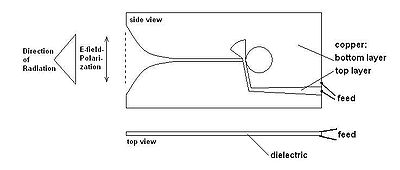

AVivaldi antennaorVivaldi aerial[1]ortapered slot antenna[2] is a co-planar broadband-antenna, which can be made from a solid piece of sheet metal, a printed circuit board, or from a dielectric plate metalized on one or both sides.

The feedline excites an open space via a microstrip lineorcoaxial cable, and may be terminated with either a sector-shaped area or a direct coaxial connection. From the open space, the signal traverses an exponentially tapered pattern via a symmetrical slot line.

Vivaldi antennas can be made for linear polarized waves or – using two devices arranged in orthogonal direction – for transmitting / receiving both polarization orientations.
If fed with 90° phase-shifted signals, orthogonal devices can transmit/receive circular-oriented electromagnetic waves.
Vivaldi antennas are useful for any frequency, as all antennas are scalable in size for use at any wavelength. Printed circuit technology makes this type antenna cost effective for microwave frequencies 1 GHz or higher.

Advantages of Vivaldi antennas are their broadband characteristics (suitable for ultra-wideband signals [3]), their easy manufacturing process using common methods for PCB production, and their easy impedance matching to the feeding line using microstrip line modeling methods.
The MWEE collection of EM simulation benchmarks includes a Vivaldi antenna.[4][5][6][7][8][9]
Several researchers have experimented variations in the shape of the Vivaldi antenna to improve some of its characteristics. An example is the Palm Tree Vivaldi Antenna, with greater gain and directivity, used in Near-Field Microwave Biomedical Imaging Applications. [10][11]
This article related to radio is a stub. You can help Wikipedia by expanding it. |